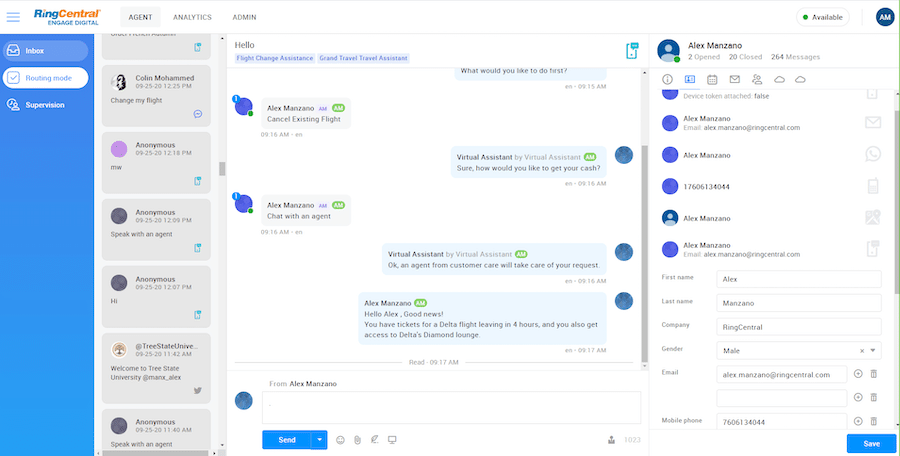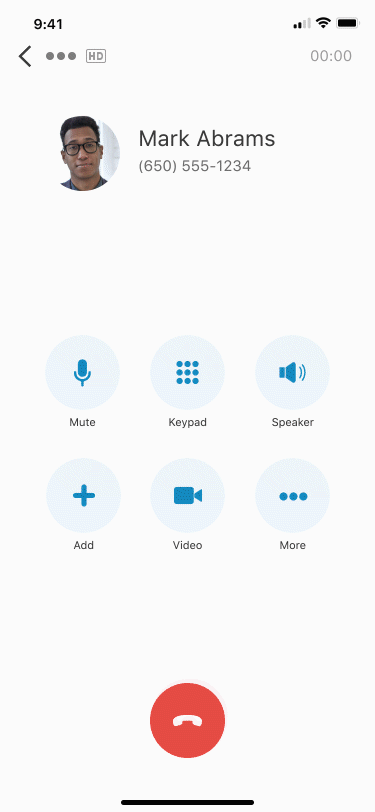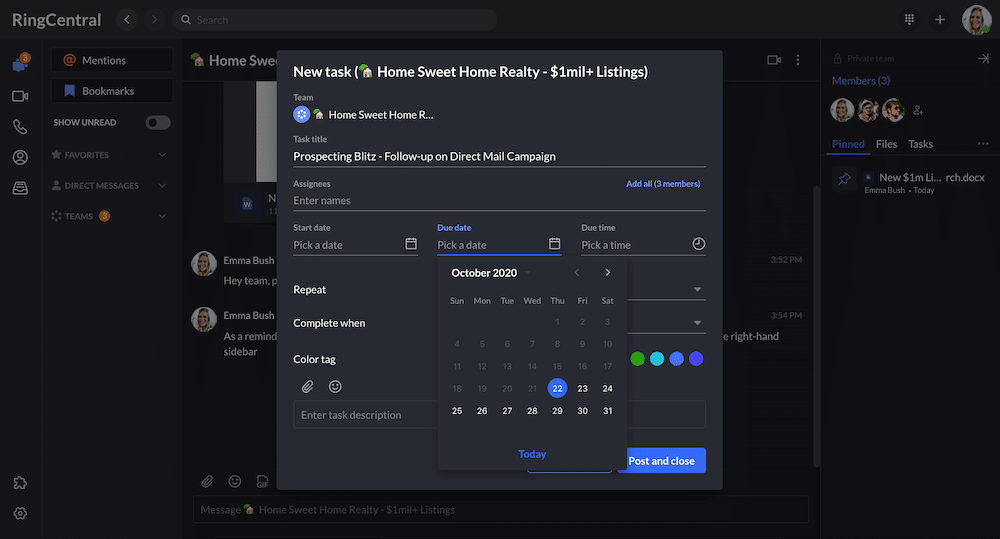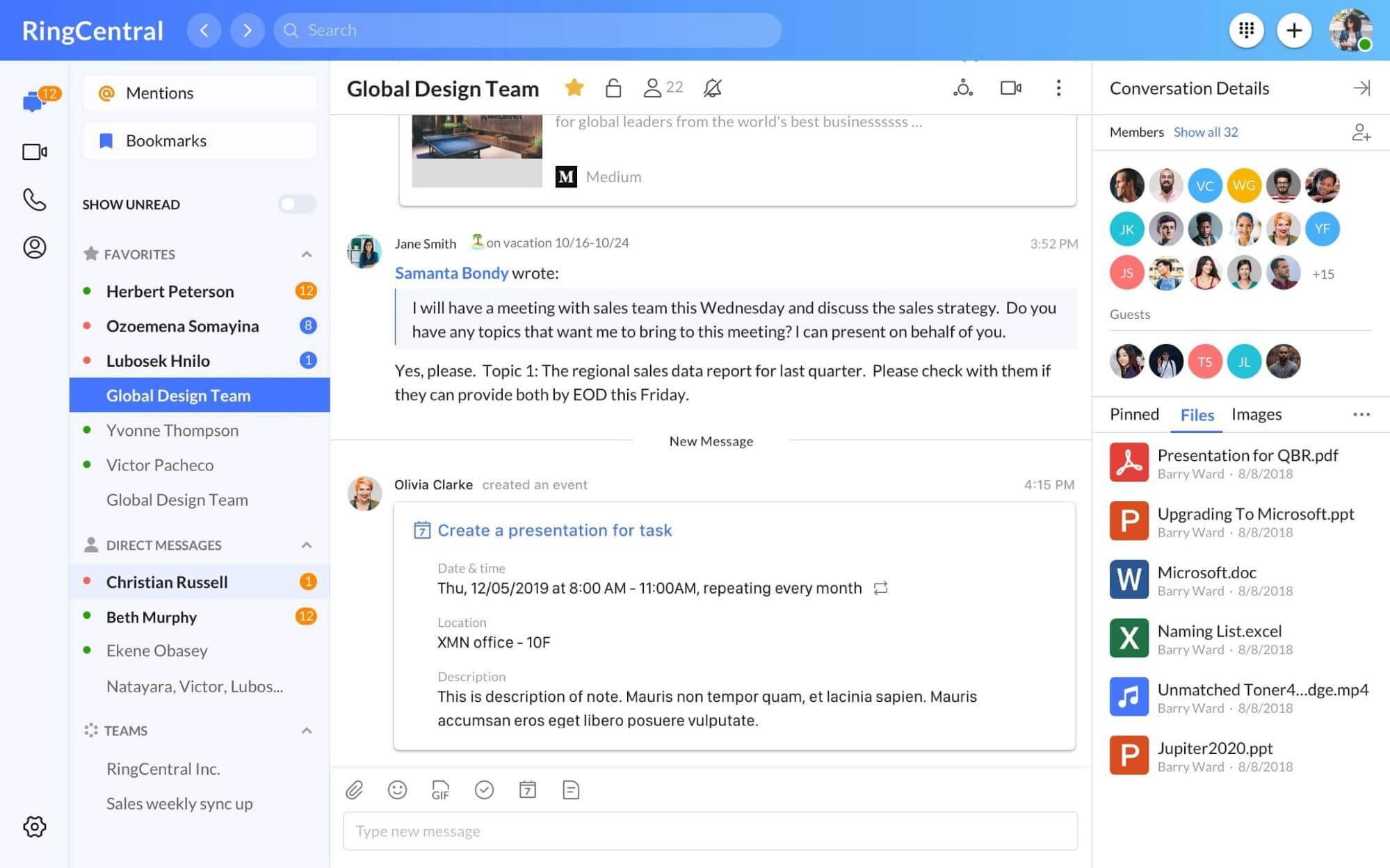Updated December 2020
Hey there. You must be here for one of the following reasons:
- You’re thinking of getting Microsoft Teams for your business.
- You’re thinking of getting RingCentral Office® for your small business.
- You’re thinking of getting either one, but aren’t sure which to go for.
Well, you’ve come to the right place. In this post, we’ve conducted an in-depth comparison of these two superstar platforms to see just how they stack up against one another.
We definitely recommend reading till the end to get all the deets on these two platforms but if you’re looking for a TL;DR, here’s a quick comparison spoiler: both apps have awesome features and, actually, a lot in common. We really like Microsoft Teams collaboration features and price points. The biggest con that we found with Microsoft Teams was their call functionality and omnichannel engagement tools are rather basic.
RingCentral, on the other hand, has very strong inbound and outbound call functionality and omnichannel customer support. It’s a bit more expensive than Microsoft Teams—however, it replaces three to five different apps in your tech stack so… is it really more expensive? We’d say cost-effective, but we’ll leave it up to you.
Also, both tools have been around for a while so they both have a proven track record when it comes to their usability for small businesses, which is always great.
Keep reading to learn how each of these platforms ranks in the following places:
Plus, check out:
📚 Learn all the facts when it comes to telephony for Microsoft Teams and find out how RingCentral can help.
RingCentral vs Microsoft Teams: Available features
Inbound and outbound call functionality
At the time this post was written, Microsoft Teams supports basic inbound call features, including call answering initiating with its integrated dialpad, call holding, call forwarding, call history, voicemail, and emergency calling. RingCentral Office offers all this plus advanced inbound call routing via automatic call distributor (ACD), including interactive voice response (IVR). Both platforms are easy to set up—no coding knowledge required.
Where RingCentral really shines, however, is with its outbound capabilities. The platform offers predictive dialing, agent scripting, and a built-in dialer:
Teams doesn’t have these features, although things like predictive dialing can be added through third-party app integrations.
Omnichannel customer engagement
If you’re looking for something to make your customer service team’s lives easier, RingCentral’s Contact Center solution lets you connect with customers through whatever channel they’re already on: phone, email, text message, social media, live chat, chatbot… you name it. No matter the channel, your agents can conveniently manage all their communications from one dashboard:

RingCentral also offers intelligent routing for all communication channels, which can improve your first-contact resolution rate beyond the phone. This is unlike Teams, which only offers intelligent routing features for phone calls.
Teams does offer an entire suite of capabilities, called Omnichannel for Customer Service, dedicated to enabling organizations to connect and engage with their customers across various digital messaging channels as well, but with an additional license and cost.
Team communication
Information silos are detrimental to customer experience, and frankly, not empowering for your team. That’s why it’s so important to have a platform that lets your team collaborate to drive that dream customer and employee experience company-wide.
To facilitate this, RingCentral’s platform has built-in team messaging, phone calling, and video conferencing all at your fingertips:
This allows you to get answers quickly and be available through different channels when you’re following up with teammates and talking to customers. For example, if you’re on a voice call with a client, but the conversation’s getting serious (or you just want to screen share), you can easily flip your call to a video conference with one tap:

Pin conversations for later, and create group chats and tasks:

We’ll be real though, Microsoft Teams has a longer history on the document collaboration front. Right in the app, users are able to co-edit Word, Excel, and PowerPoint files since they’re all built into the Microsoft’s suite.
However, RingCentral does integrate with Google Drive to allow you to upload and share your documents, presentations, and spreadsheets from either your drive or your computer, right within a team conversation:
🕹️ Get a hands-on look at how RingCentral works by booking a product tour:
💰 You can also use this calculator to see roughly how much your business could save by using RingCentral to support your team’s communication with each other, freelancers, clients, and more.
Reporting and analytics
Contact center metrics and app usage metrics in general are crucial to really understand how well your team is meeting your customers’ needs. Both Microsoft Teams and RingCentral offer analytics, so you can track this information, get real-time data, generate custom reports, and even monitor calls and speech. Your organization can then use this information to drive better business decisions and inform future training.
Third-party integrations
RingCentral integrates with over 180 different third-party apps (yes, that includes business favorites like HubSpot and Salesforce). Microsoft Teams integrations capabilities are mostly focused on other Microsoft apps, making it perfect for people who have an all-Microsoft tech stack.
So… who has the best features?
It’s pretty close but RingCentral has more advanced call features and a better omnichannel customer engagement experience than Microsoft Teams. Plus, while it’s a bit more pricey at face-value, you get everything you need with just one system and can even replace some of your existing ones.
We will hand it to Teams though. Their video conferencing and team collaboration features are very powerful, also making them an exceptional option.
RingCentral vs Microsoft Teams: Quality of service
Both RingCentral and Teams are cloud-based, meaning that they both offer the same level of convenience and flexibility that can’t be matched by on-site setups.
RingCentral has the renowned “five 9s,” or 99.999% SLA, which is equivalent to less than 6 minutes of downtime a year. Microsoft’s SLA, on the other hand, is 99.9%, which is about a business day of downtime a year.
RingCentral vs Microsoft Teams: Security
Neither RingCentral nor Microsoft Teams play around when it comes to security. Both platforms have an impressive list of credentials and are both compliant with industry-specific security standards for healthcare (HIPAA) and finance (AICPA SOC 2 and 3), plus other international, cross-industry certifications.
When it comes to protecting your business’s information, you’re in safe hands with either of these platforms.
RingCentral vs Microsoft Teams: Scalability
Being a small business, we’re going to take a wild shot in the dark here and assume that growth is really high up on your priority list. So scalability is super important to you in a platform.
Going with a scalable platform from the get-go will save you the time, money, and hassle of having to migrate all of your information to a more robust platform down the road.
While both RingCentral and Microsoft Teams tick the scalability checkbox, RingCentral did beat Teams as PCMag’s Editors Choice for business communications (not to brag or anything). Honestly though, when it comes to scalability, neither of these platforms will disappoint.
RingCentral vs Microsoft Teams: Pricing
Microsoft Teams ranges from $5–$20 per user per month on an annual plan. RingCentral Office plans cost $20–$50 per user per month on an annual basis, but we also understand that every business is different, so naturally, the cost will vary from one to another.
Remember that RingCentral is designed to replace multiple apps you might currently be paying for, and gives you the added bonus of not having to constantly toggle between different apps during your workday—just something to keep in mind.
Not ready to commit? Both platforms offer free demos, so you can take them each out for a test drive before making a decision.
RingCentral vs Microsoft Teams: Customer reviews
Still not convinced which platform is right for you? Here we’ve included customer reviews from small business owners like yourself.
RingCentral scored a 4.5 out of 5 by PC Magazine and was dubbed an “Editors’ Choice.” Here’s what some customers have to say about the cloud-based business communications system:
“We’re going to be running [two] companies using the same team and the same resources. A lot of what’s making this possible is that we now have the communication and automation tools to increase our capacity without needing a lot of additional staff. We couldn’t do a lot of what we’re doing without tech automation like RingCentral.” – Chais Meyer, co-owner of 24 Hour Tees. Learn more about how 24 Hour Tees is using RingCentral to scale up while keeping customer service personal.
“RingCentral Office is a well rounded VoIP software that includes all features that a sales team needs: artificial intelligence (AI), integration to SalesForce, and video conferencing. Additionally, RingCentral offers a phone app that is super easy to navigate and makes remote calls a breeze. It is easy to communicate with people internally within the organization via an easy to use search bar; and calling externally is likewise an easy process, as its just a matter of copy and pasting a number (even if there are hyphens in the number it registers). It’s great that you don’t need a physical phone on your desk to use RingCentral – all you need are headphones and an internet connection. My absolute favorite part of RingCentral is that it allows you to call from a “local number”, meaning respective area codes will pop up on phones you are calling.” – Slavka T, Business Development Representative
Microsoft Teams scored 4 out of 5 by PC Magazine. Here’s what their customers have to the say:
“I have been using, configuring and deploying Microsoft Teams on the last two years, it is a very solid tool not only for communication, also for collaboration. With this pandemic situation, my company is working totally online, and Teams has been a awesome tool to provide Apps, meetings, dashboards, presentations, and the live event features are very impressive, if you go deeply on it, you have almost a television channel operating on your computer.” – André from Hexis Científica Ltda.
“Integration with the rest of the [Microsoft] ecosystem is the biggest thing Teams has going for it. It allows easy chat/calls from Outlook and the like. The support was pretty good, as it should be from a multi-billion dollar company, and usually found the problem eventually.” – Daniel from Dragon Veterinary
Final thoughts
Okay, so after comparing the two platforms we can confidently say both are good candidates for your small business. If we had to pick, however, RingCentral is the winner because:
- It has more built-in feature is like inbound call routing via ACD, IVR, and agent scripting
- It offers a 99.999% uptime SLA for all customers at any price tier at no additional cost
- It integrates with more alternative messaging apps, making it easier to have everything in one place
- It eliminates the need for several other apps with just once license, getting you more bang for your buck
Still not convinced? Check out Glip vs Microsoft Teams. Take RingCentral for a spin yourself and see what you think before pulling the trigger on your decision. Both RingCentral and Teams offer free demos. Check out a product tour of RingCentral Office, or visit Microsoft’s Teams website to get a walkthrough of their product.
Frequently asked questions
Do either RingCentral or Microsoft Teams require any kind of special hardware?
Nope! Both platforms are cloud-based and able to connect to your existing devices for both inbound and outbound communications.
Do these platforms offer training to new customers?
You bet. Both RingCentral and Microsoft Teams want to make sure that you get started on the right foot so training is provided when you make the decision to go with either platform.
Is there an app my team has to download to use either platform?
You can, but both programs are totally accessible through a web browser. One of the benefits of using cloud-based software is you can access it from any device remotely. Both RingCentral and Microsoft Teams have a mobile app well, making them perfect for communications on the go.
I want to provide international numbers for my customers in other countries… can I do that with RingCentral and Microsoft Teams?
Sure can! With RingCentral’s phone system, you can provide local, toll-free, and dial-in international numbers for over 40 countries at no extra cost. For countries outside this list, you can purchase numbers. Microsoft Teams has the same capabilities, providing a global dial-in number to join a meeting from any mobile device. Additional charges may apply, however, so make sure you bring this up with your sales rep if you decide to go with Teams.
How many languages are these platforms available in?
RingCentral offers speech recognition in 72 languages. As of the writing of this post, Microsoft Teams offers speech recognition in 53 languages.
Do RingCentral and Microsoft Teams integrate with other solutions?
Definitely. RingCentral and Microsoft Teams both integrate with a ton of other solutions including Salesforce, Canvas, and Zendesk. Check out the full list of RingCentral integrations on the apps page, or visit Microsoft’s website to view theirs.
Originally published Dec 01, 2020, updated Aug 25, 2021







